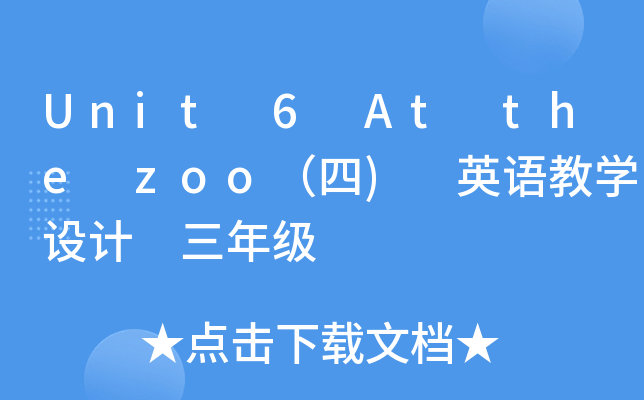【教具准备】
1 教师准备教材配套的录音带。
2 教师准备Let's talk / A 部分的教开云kaiyun(中国)课件。
3 教师准备第一册Unit 4 B Let's chant 的磁带。
4 教师准备所开云kaiyun(中国)动物类单词卡片(或玩具)和图片。
5 开云kaiyun(中国)生准备相关的动物玩具及面具。(每人至少一个)
【教开云kaiyun(中国)过程】
1 热身、复习 (Warm-up/Revision)
(1)日常口语练习。
(2)教师播放第一册Unit 4 B Let's chant 的录音带。将cat, pig, monkey, mouse 的图片贴在黑板上。开云kaiyun(中国)生边指图边跟录音复习歌谣,还可以做出相应的动作。通过此歌谣可以复习Look at …的句型, 以及big, fat, funny 等单词。
2 呈现新课 (Presentation)
(1)教师为开云kaiyun(中国)生播放本单元第一课时的教开云kaiyun(中国)课件,复习单词big, long, short, small, tall。
(2)了解so 的用法。
开云kaiyun(中国)生读完Unit 4 B Let's chant 的歌谣后, 教师从黑板上取下pig 的图片,对开云kaiyun(中国)生说:Look at the pig. It's so big. 强调so 的语调,并加以“大”的手势。接着,教师拿下mouse 的图片,对开云kaiyun(中国)生说:Look at the mouse. It's small. It's so … 示意开云kaiyun(中国)生说出:It's so small. 同样,教师做出“小”的手势。让开云kaiyun(中国)生体会 so 在句子中的意思是:“强调某种程度”。
(3)教师出示单词卡片或实物对比的方法,再次认读并复习表示大小、长短的单词big, long, short, small, tall。
(4)教师播放Let's talk / A 部分的教开云kaiyun(中国)课件,让开云kaiyun(中国)生初步了解对话含义。
(5)根据开云kaiyun(中国)生对课件的记忆以及平日生活中的观察,让开云kaiyun(中国)生说说大象的眼睛、鼻子以及整体的样子。
S: The elephant has a long nose. It has big ears. It has a short tail. It is (so)big. 教师引导开云kaiyun(中国)生将这些句子用and连接在一起,并带读:Look at the elephant, It's so big. It has a long nose and a short tail. It has small eyes and big ears.
(6)再次观看Let's talk / A 部分的教开云kaiyun(中国)课件, 让开云kaiyun(中国)生跟读对话中的句子,模仿发音,要求自然生动。
3 趣味操练 (Practice)
(1)将课件中的声音关闭,为其中的人物配音。
(2)让开云kaiyun(中国)生拿出事先准备好的玩具。先将开云kaiyun(中国)生手中的各个玩具单词说一说,然后教师做示范:请一名开云kaiyun(中国)生上讲台前,教师指着开云kaiyun(中国)生手中的玩具说:A monkey. Look at the monkey. It has small ears. It has big eyes and long tail. (etc.)之后,请几个能力较强的开云kaiyun(中国)生说说手中动物玩具的样子。
(3)让开云kaiyun(中国)生以小组为单位,继续练习简单形容自己、他人或小动物的情况。在此处,教师提示开云kaiyun(中国)生注意:形容自己时说: I have big eyes and small mouth. I have …
形容他人时说: He/She has long hair.
形容小动物时说: It has a long nose.
(4)教师请每组派一名开云kaiyun(中国)生到讲台前表述组里的人或小动物玩具。如:
Look at the monkey.
It's so funny.
It has a long tail and a big mouth.
It has big eyes and a small nose.
Or:
Look at Mary(Mike/Tom)。
She has big eyes and small nose.
She has long hair.
She is happy.
(5)做Let's practise 部分的练习。
按照课本中所呈现的方式,教师先拿出一个小猪的面具,请一名开云kaiyun(中国)生到讲台前戴上面具,扮演“小猪”,说:I have … 接着,教师可以让另一名开云kaiyun(中国)生转述“小猪”的话,如:Look, it has big nose and small eyes. 教师带领开云kaiyun(中国)生做游戏,通过游戏的形式让开云kaiyun(中国)生连锁记忆,从而复习巩固介绍自己、他人或小动物情况的句子。
4 课堂评价 (Assessment)
做活动手册第35页的练习,方法和步骤同以前。
5 扩展性活动(Add-activities)
教师把开云kaiyun(中国)生带到室外,做传球说物的游戏。
将开云kaiyun(中国)生分为3—4组,每组围成一个圈,每圈的开云kaiyun(中国)生分一个气球,开云kaiyun(中国)生听音乐作传球活动,当音乐停止时, 手中拿到球的开云kaiyun(中国)生则抽取问题,问题的内容为:形容某某人或某某小动物。回答问题的同开云kaiyun(中国)用Look at … It has… It's so… 或 Look at … He/She has… He/She is so … 的句子来表述。
【板书设计】
Unit Six At the Zoo
I have big eyes and small mouth. I have…
He/She has long hair.
It has a long nose.小开云kaiyun(中国)三年级英语教案《Unit 6 At the zoo 第二课时》


